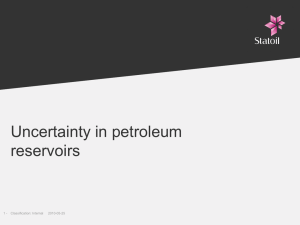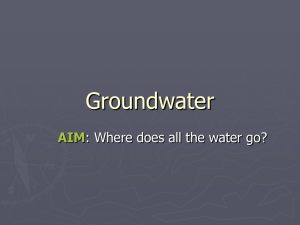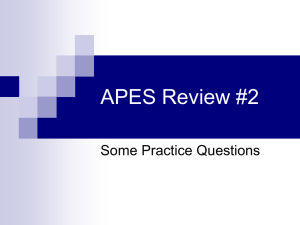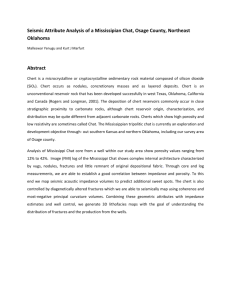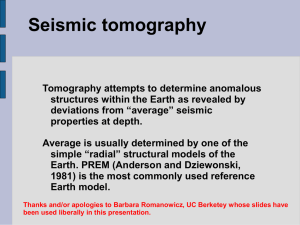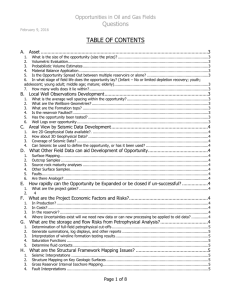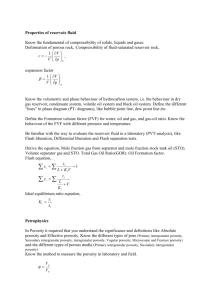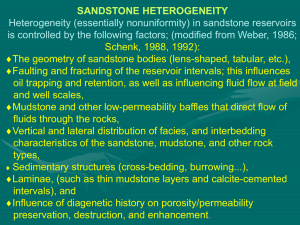PosterExample - University of Houston
advertisement
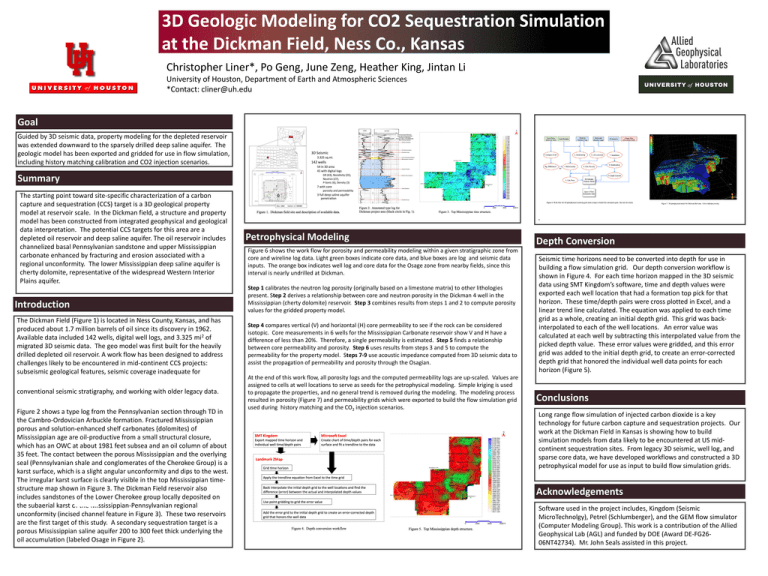
3D Geologic Modeling for CO2 Sequestration Simulation at the Dickman Field, Ness Co., Kansas Christopher Liner*, Po Geng, June Zeng, Heather King, Jintan Li University of Houston, Department of Earth and Atmospheric Sciences *Contact: cliner@uh.edu Goal Guided by 3D seismic data, property modeling for the depleted reservoir was extended downward to the sparsely drilled deep saline aquifer. The geologic model has been exported and gridded for use in flow simulation, including history matching calibration and CO2 injection scenarios. A B Summary The starting point toward site-specific characterization of a carbon capture and sequestration (CCS) target is a 3D geological property model at reservoir scale. In the Dickman field, a structure and property model has been constructed from integrated geophysical and geological data interpretation. The potential CCS targets for this area are a depleted oil reservoir and deep saline aquifer. The oil reservoir includes channelized basal Pennsylvanian sandstone and upper Mississippian carbonate enhanced by fracturing and erosion associated with a regional unconformity. The lower Mississippian deep saline aquifer is cherty dolomite, representative of the widespread Western Interior Plains aquifer. C 40 μm . Petrophysical Modeling Figure 6 shows the work flow for porosity and permeability modeling within a given stratigraphic zone from core and wireline log data. Light green boxes indicate core data, and blue boxes are log and seismic data inputs. The orange box indicates well log and core data for the Osage zone from nearby fields, since this interval is nearly undrilled at Dickman. Step 1 calibrates the neutron log porosity (originally based on a limestone matrix) to other lithologies present. Step 2 derives a relationship between core and neutron porosity in the Dickman 4 well in the Mississippian (cherty dolomite) reservoir. Step 3 combines results from steps 1 and 2 to compute porosity values for the gridded property model. Introduction The Dickman Field (Figure 1) is located in Ness County, Kansas, and has produced about 1.7 million barrels of oil since its discovery in 1962. Available data included 142 wells, digital well logs, and 3.325 mi2 of migrated 3D seismic data. The geo model was first built for the heavily drilled depleted oil reservoir. A work flow has been designed to address challenges likely to be encountered in mid-continent CCS projects: subseismic geological features, seismic coverage inadequate for Step 4 compares vertical (V) and horizontal (H) core permeability to see if the rock can be considered isotopic. Core measurements in 6 wells for the Mississippian Carbonate reservoir show V and H have a difference of less than 20%. Therefore, a single permeability is estimated. Step 5 finds a relationship between core permeability and porosity. Step 6 uses results from steps 3 and 5 to compute the permeability for the property model. Steps 7-9 use acoustic impedance computed from 3D seismic data to assist the propagation of permeability and porosity through the Osagian. conventional seismic stratigraphy, and working with older legacy data. Figure 2 shows a type log from the Pennsylvanian section through TD in the Cambro-Ordovician Arbuckle formation. Fractured Mississippian porous and solution-enhanced shelf carbonates (dolomites) of Mississippian age are oil-productive from a small structural closure, which has an OWC at about 1981 feet subsea and an oil column of about 35 feet. The contact between the porous Mississippian and the overlying seal (Pennsylvanian shale and conglomerates of the Cherokee Group) is a karst surface, which is a slight angular unconformity and dips to the west. The irregular karst surface is clearly visible in the top Mississippian timestructure map shown in Figure 3. The Dickman Field reservoir also includes sandstones of the Lower Cherokee group locally deposited on the subaerial karst of the Mississippian-Pennsylvanian regional unconformity (incised channel feature in Figure 3). These two reservoirs are the first target of this study. A secondary sequestration target is a porous Mississippian saline aquifer 200 to 300 feet thick underlying the oil accumulation (labeled Osage in Figure 2). Depth Conversion A At the end of this work flow, all porosity logs and the computed permeability logs are up-scaled. Values are assigned to cells at well locations to serve as seeds for the petrophysical modeling. Simple kriging is used to propagate the properties, and no general trend is removed during the modeling. The modeling process resulted in porosity (Figure 7) and permeability grids which were exported to build the flow simulation grid used during history matching and the CO2 injection scenarios. B C 25 μm Seismic time horizons need to be converted into depth for use in building a flow simulation grid. Our depth conversion workflow is shown in Figure 4. For each time horizon mapped in the 3D seismic data using SMT Kingdom’s software, time and depth values were exported each well location that had a formation top pick for that horizon. These time/depth pairs were cross plotted in Excel, and a linear trend line calculated. The equation was applied to each time grid as a whole, creating an initial depth grid. This grid was backinterpolated to each of the well locations. An error value was calculated at each well by subtracting this interpolated value from the picked depth value. These error values were gridded, and this error grid was added to the initial depth grid, to create an error-corrected depth grid that honored the individual well data points for each horizon (Figure 5). Conclusions Long range flow simulation of injected carbon dioxide is a key technology for future carbon capture and sequestration projects. Our work at the Dickman Field in Kansas is showing how to build simulation models from data likely to be encountered at US midcontinent sequestration sites. From legacy 3D seismic, well log, and sparse core data, we have developed workflows and constructed a 3D petrophysical model for use as input to build flow simulation grids. Acknowledgements Software used in the project includes, Kingdom (Seismic MicroTechnolgy), Petrel (Schlumberger), and the GEM flow simulator (Computer Modeling Group). This work is a contribution of the Allied Geophysical Lab (AGL) and funded by DOE (Award DE-FG2606NT42734). Mr. John Seals assisted in this project.

